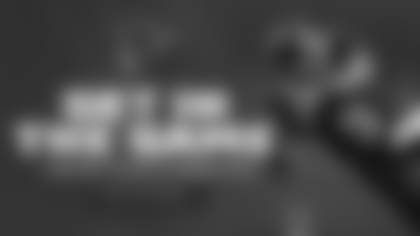FLOWERY BRANCH, Ga. — The knuckleball got the best of the Atlanta Falcons' kickoff return unit in the team's Week 3 loss.
To prevent it from happening again, the Falcons' special teams players repped that style of kick "a lot" to prepare for Sunday's game against the Washington Commanders (1 p.m. ET, CBS).
"Even after practice, me, Jamal (Agnew) and all the kick returners, we just got a kicker and told him to kick us the craziest ball he can," Falcons cornerback and return man Natrone Brooks said. "Let us go out there and field them."
Over and over and over again.
The repetition is needed because no two knuckleballs are the same. And, just as a knuckleball is difficult to hit in baseball, these kicks are tricky to field cleanly.
"It flies in a similar way," Brooks said. "Of course it's not as small as a baseball, so it's not as much movement, but it moves weird. If I could explain it, it's still spiraling, but at the same time, in the air while spiraling, it's going left and right; then, it just dies down on you. It's crazy."
There were two obvious instances of the knuckleball hurting the Falcons in their loss to the Carolina Panthers last Sunday.
During the third quarter, after the Panthers' defensive touchdown, Nathan Carter tried to field a knuckleball off its second bounce near the 10-yard line. He dropped it in the process, and by the time he gained control of the ball, the Panthers' coverage team was on him. The Falcons started their next offensive drive at the 10-yard line.
Then, during the fourth quarter, after the Panthers' final touchdown, Brooks attempted to field a knuckleball off its first bounce around the 15-yard line. However, the ball bounced away from his location. He recovered it inside of the 5-yard line with the coverage team already at the 15, leaving him no time to mount a return. Brooks was tackled at the 10-yard line.
"The trick to it is just urgency and kind of watching the nose of it," Brooks said. "Sometimes you can where the nose is going to hit. Me, personally, I played baseball, so I got a good feel of where it's going to bounce. But still, I don't know.
"If you watch one of the plays with Carolina, I thought it was going to bounce right back to me, and it took a bounce and went all the way to the right. It was just one of those bounces. It's not going to happen like that often, but you never know."
The knuckleball didn't just give the Falcons problems last week. It tripped up the Philadelphia Eagles, too. Though they won their game, the Los Angeles Rams didn't make it easy for them. The Eagles started five of their 11 drives at or behind the 20-yard line after a kickoff return.
Seven of the Falcons' 11 total drives against the Panthers began after a kickoff, and four of those possessions started at or behind the 20-yard line.
"This new kickoff has presented some challenges with this knuckleball kick," Falcons head coach Raheem Morris said. "It's presented some challenges if you don't field those things the right way. If you don't field it off that one bounce, if you mishandle one little kickoff and you mishandle it a little bit to the right and you get the bad bounce, it's going to be tough. That's something that we've definitely been locked into and talking about."
The NFL implemented the “Dynamic Kickoff” rules in 2024, but it tweaked a touchback spot for 2025. The minor remains the 20-yard line. But the major is now the 35-yard line rather than the 30. And then, if a kick is short of the landing zone and therefore not playable in any sense, it's a 40-yard penalty.
Falcons special teams coordinator Marquice Williams explained why those details have led to the knuckleball, because it wasn't nearly as common last year and definitely wasn't in years prior.
"If you kicked a 4.2 (second) hang-time kickoff, and you're running from the old kickoff, your coverage team would usually be inside the 30-yard line (when it's) caught it at the 5," he said. "Now, if you hit that same football and you catch it at the 5-yard line, the coverage team's at the 40-yard line. So, it's 10 yards of space. How do you get that space back? You put the ball on the ground or somebody drops the ball. Then, they're able to react and they're able to steal yards coverage wise to put them in a better position like the old kickoff rule. So, that's kind of where it's coming from."
Basically, the knuckleball, when not caught or fielded quickly, gives the kickoff team a better opportunity to reach the returner before he can pick up yards. It's risky because the kick could very well result in a touchback if not executed well, or the coverage may not be close enough if the other team handles the ball without issue. But the reward can clearly be worth it if so.
Best believe, opponents will take any type of advantage they can.
"Since we put that on film, I think it's definitely something teams are going to try to attack us with," Brooks said. "It's just something we got to clean up, and we did a good job this week of practicing it."














